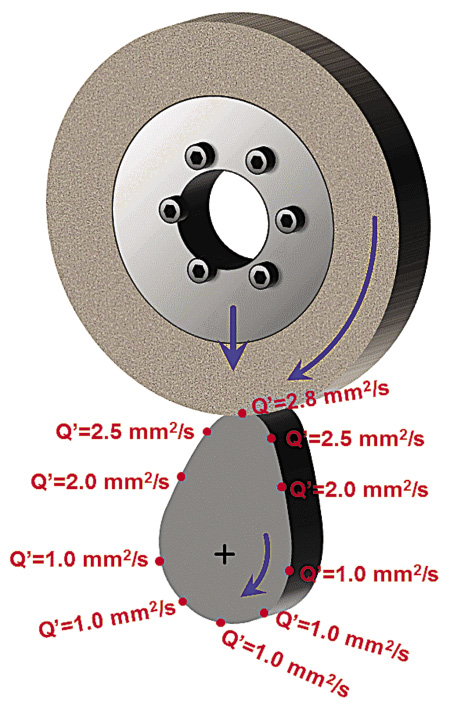Dear Doc: I grind cams and have the option of doing “constant rpm” or “constant metal-removal rate.” What’s the difference?
The Doc Replies: Cam grinding is just a funky type of cylindrical grinding, where the shape isn’t a basic circle but sort of an egg shape, which creates special challenges.
In plunge-type cylindrical grinding, the basic equation for specific mrr (smrr) is:
smrr (mm2/sec.) = DOC (mm) × workpiece surface velocity (mm/sec.).
But here’s where it gets tricky. The workpiece surface velocity gets faster as the contact point of the wheel and cam gets farther from the axis of rotation. This changes the equation to:
smrr (mm2/sec.) = DOC (mm) × π × 2 × workpiece radius at contact (mm) × workpiece rpm ÷ 60.
That means surges occur in the smrr, increasing wheel wear and the risk of burn.
As a result, some clever people developed constant-smrr grinding. Here, the workpiece speeds up and slows down within one revolution, keeping the smrr constant and minimizing the surges.
This is a better approach, because racing through those periods where the workpiece radius is small reduces cycle time. In addition, slowing down during those periods where the radius is large reduces wheel wear and the risk of burn.


Changes in the metal-removal rate when grinding at a constant rpm. Illustration courtesy J.Badger.

But even this approach has issues. When the workpiece slows down, chip thickness decreases, which increases the amount of rubbing, heat generation and, at least relatively, the risk of burn. Also, slowing down increases the time a point on the workpiece is in the hot zone, which raises the temperature. Finally, when grinding the flat portion of a cam, the contact area between the wheel and workpiece increases, further increasing the risk of burn, and when grinding the round portion, the contact area decreases, lowering the temperature but consuming the wheel quicker.
To complicate matters, there’s the decision about whether to take numerous high-rpm passes with a small DOC or fewer low-rpm passes with a larger DOC. The better option depends on the desired amount of jerk, which is the rate of acceleration change. Jerk limitations place constraints on how quickly you can oscillate the wheelhead spindle up and down, and how quickly you can vary the workpiece rpm. In general, a fast rpm and a small DOC will produce the lowest temperatures and the most wheel wear—within the jerk limitations of the machine.
Last year, I was involved in a fascinating project to optimize cam grinding for a major European truck manufacturer. Instead of using the constant-rpm or constant-mrr process, we developed the constant-temperature process, a complex, dynamic model of the ever-changing contact between the wheel and workpiece. We then measured the grinding power and determined a cycle that produced a near-constant temperature throughout the cycle, eliminating burn and minimizing wheel wear. Read about it at cteplus.delivr.com/2h3bq.
Related Glossary Terms
- computer-aided manufacturing ( CAM)
computer-aided manufacturing ( CAM)
Use of computers to control machining and manufacturing processes.
- cylindrical grinding
cylindrical grinding
Grinding operation in which the workpiece is rotated around a fixed axis while the grinding wheel is fed into the outside surface in controlled relation to the axis of rotation. The workpiece is usually cylindrical, but it may be tapered or curvilinear in profile. See centerless grinding; grinding.
- flat ( screw flat)
flat ( screw flat)
Flat surface machined into the shank of a cutting tool for enhanced holding of the tool.
- grinding
grinding
Machining operation in which material is removed from the workpiece by a powered abrasive wheel, stone, belt, paste, sheet, compound, slurry, etc. Takes various forms: surface grinding (creates flat and/or squared surfaces); cylindrical grinding (for external cylindrical and tapered shapes, fillets, undercuts, etc.); centerless grinding; chamfering; thread and form grinding; tool and cutter grinding; offhand grinding; lapping and polishing (grinding with extremely fine grits to create ultrasmooth surfaces); honing; and disc grinding.
- metal-removal rate
metal-removal rate
Rate at which metal is removed from an unfinished part, measured in cubic inches or cubic centimeters per minute.


 ARTICLES
ARTICLES



